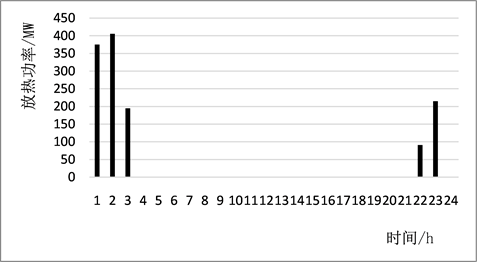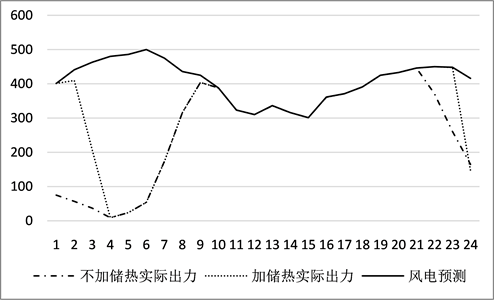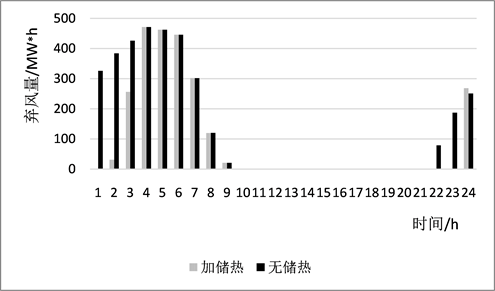1. 引言
2016年,全国风电保持健康发展势头,但弃风问题严重 [1] ,全年弃风电量497亿千瓦时。在我国北方冬季实行“以热定电”的运行模式,热电机组为保证供热而大幅度提高其最小出力,直接制约了电力系统整体的调峰能力,导致风电的上网空间不足,造成大量弃风 [2] [3] 。
为扩大风电运行可行域,解决冬季“以热定电”的刚性耦合关系,储能技术以其良好的互补性得到了广泛关注 [4] [5] [6] 。在大容量储能中,除抽水蓄能比较成熟以外,其它储能方式都面临着各种各样的问题不能大容量的存储。为此文献 [7] [8] 提出通过利用储热装置提高热电机组运行的灵活性,分析了大容量储热装置提升风电消纳能力的应用前景。文献 [9] 介绍了储热装置打破“以热定电”的热电耦合关系的基本原理,并分析了储热装置不同的安装位置对风电消纳的效果。文献 [10] 分析了蓄热罐提升风电接纳量的机理,以系统煤耗量最小为目标函数建立了包含风电、纯凝机组、热电机组和蓄热罐的综合调度模型。文献 [11] 建立了含风电、纯凝机组、热电联产、储热装置的电力系统调度模型,并比较了风电供热与热电厂配置储热装置的节煤效果。文献 [12] 以系统的发电成本最小为调度目标建立了含蓄热罐及电锅炉的电热综合调度模型。然而,目前文献中的目标函数大都只单独考虑了系统的运行成本或者弃风量,没有真实的反映系统的调度情况。
本文在以上文献的研究基础上,介绍了实际工程中热电厂加装储热装置的安装位置及运行流程。构建了含储热热电联产机组的风电消纳优化调度模型,在目标函数中加入了弃风成本及热电机组及常规机组的运行成本,并采用YALMIP工具箱的商业求解器Gurobi进行求解,比较了不含储热的供热方式与热电联产机组配置储热时供热的消纳弃风效果。
2. 热电厂配置储热工作原理
2.1. 热电机组工作原理
将热电机组发电功率和供热功率之间的关联偶合关系称为“电热特性” [11] ,抽汽式供热机组的电热特性曲线如图1所示。
为每增大单位的供热量时机组最小电出力的增加量,
和
分别为最大电出力和最小电出力下的对应值,K为常数;Hmax为机组的最大热出力,Hmed为机组在发电功率最小时的供热功率。由图中可以看出当供热功率H一定时,热电机组可以通过调节凝汽汽流的大小来调整电出力,其调节范围是[PE,PF],热电机组的热出力越大其电出力的调节范围就会越小。
2.2. 热电机组加装储热装置后工作原理
热电机组加装储热装置后,其“电热特性”将会发生很大的改变 [12] ,如图2所示,由原来的ABCD区间变为LMNOQD区间,机组的最大供热功率由原来的Hmax增大到H+cr.max,当供热功率H一定时,机组的电功率调节范围由[PE, PF]增大为[PG, PI],这是因为储热装置使机组的供热方式更加灵活,当供热功率一定时,可以有效的降低热电机组的发电出力,机组少发的热由储热装置补偿,为风电提供上网空间。
热电机组加装储热装置时的原理图如图3所示,储热时从热电机组抽供热管道接一路蒸汽(厂房外)至储热站蒸汽–热水换热器,储热装置里面介质与蒸汽–热水换热器进行热交换,介质吸热后储存于储热装置,放热时热网循环泵出口侧接一路热网循环水与储热装置进行热交换,储热装置介质放热加热热网循环水,热网循环水加热后进入热网加热器E入口管道。

Figure 1. Heat-electricity relationship of CHP unit
图1. 常规热电机组运行特性

Figure 2. Heat-electricity relationship of CHP unit with TES
图2. 含储热的热电机组运行特性

Figure 3. Heat accumulator integrated in a heat supply system
图3. 储热装置在供热系统中的连接图
2.3. 协调供热综合系统结构
北方地区热力系统和电力系统有着紧密的联系,在电源侧加装储热装置可以使机组的出力更加灵活,可以有效的解决风电消纳问题。含储热热电联产机组协调供热的综合系统的结构如图4所示。
3. 含储热的热电调度模型
3.1. 调度模型目标函数
以弃风量最小为目标函数
(1)
式中
分别为1天的时段数、风电场数和常规机组数;
为第i个风电场t时刻弃风;
为常规机组出力;
为热电机组出力;
为机组发电成本,运行成本用二次函数
表示和
为启停成本,用
表示;
表示罚因子,
取
。
3.2. 系统约束
功率平衡约束
(2)
式中
为风电场i时刻t预测出力;
为时刻t系统用电负荷。

Figure 4. Structure diagram of cimbined heat and power system
图4. 协调供热综合系统结构图
3.3. 热力系统约束
3.3.1. 储热装置约束
1) 容量约束
(3)
式中
为t时刻的储热容量,
为最大储热容量
2) 储放热功率约束:
(4)
式中
,
为t时刻储热装置的储热功率和放热功率,其最大值为
,
。
3) 状态约束
(5)
储热装置储热量受漏热损失和储放热功率的影响。
为漏热损失系数。此外,储热装置的运行一个周期(如1天)后,储热量需要恢复到初始量。
3.3.2. 热负荷约束
(6)
储热装置释热功率加上热电联产机组或电供热直供的供热功率,要满足热负荷需求。
3.4. 热电联产机组约束
1) 热电比约束
对于背压式热电机组来说,该类型的第i台机组电出力
完全由其热出力
决定,如式(7)所示。
(7)
为热电机组i在t时刻的电出力,
为热电机组i在t时刻的热出力,
为热电机组的热电比。
抽汽式热电机组在满足运行条件下可以通过调节抽汽量来调整热电比,其约束为式
(8)
在实际运行中,抽汽式热电机组一般都运行在固定热电比模式。
2) 运行区间约束
(9)
3) 机组爬坡率约束
(10)
式中
,
分别为机组每分钟向上/向下爬坡速率极限。
4) 储热装置连接约束
(11)
热电机组的热出力
要满足储热功率
与直接供热功率
之和。
3.5. 常规机组约束
1) 常规机组出力约束
(12)
式中
,
,
,
分别为机组i的最小出力、最大出力、向下、向上爬坡率极限。
2) 机组启停出力约束
(13)
3) 正、负旋转备用约束
(14)
式中
为系统旋转备用额度,取系统发电最高负荷的7%。
4) 网络安全约束
电网各支路潮流需在限值之内
(15)
式中
为支路
时刻t的潮流;
,
分别为支路潮流
的最大和最小传输极限。
4. 算例分析
4.1. 仿真算例
为验证模型的有效性以及热电机组配置储热装置对消纳风电的作用,本文以当前我国北方某省电网实际电源结构比例,简化取某地区电网电源装机容量结构如表1所示。
其中,热电机组共7台,均为大型抽汽式机组(300 MW和200 MW两类),2台常规机组(300 MW和600 MW两类),具体发电机组相关特性参数参见附录A。建有一个热容量为2000 MWh的蓄热罐,最大蓄、放热功率为600 MW (足够大,运行中不受蓄热罐参数影响),采用以热定电的方式运行,热电比为1.15。具体发电机组相关特性参数和供热期内电负荷、热负荷、风电预测出力等数据参见附录A。
为简化分析,暂不考虑网络约束的影响,主要考虑全系统的有功功率平衡。算例分别采用以下两种方式进行仿真:
方式一:储热方式不工作,系统由传统的热电联产机组对热负荷进行供热,采用以热定电的方式运行,热电刚性耦合使风电上网量减少,易出现弃风现象。
方式二:由配置储热的热电厂进行供热,通过对储热装置的灵活调节进行供热,从而打破以热定电的刚性耦合,为风电的上网提供一定的空间。
本算例中,取调度周期为1天,单位调度时长为1小时。采用目前流行的gurobi软件,并利用yalmip语言进行编程求解。
4.2. 算例结果分析
从图5~7中可以看出热电厂配置储热后热电厂配置储热装置后,各类型机组发电功率发生变化:在负荷低谷的22 h、23 h到次日凌晨1~3 h时段,热电机组降低了电功率,而与此同时,风电上网功率得到增加,这是因为在凌晨时处于弃风的高发时段,而且储热装置处于放热的工作状态,从而降低热电机组的发电出力,为风电上网提供消纳空间。由图8可知储热装置从早上10点到晚上21点之间都工作在储热状态,最大的储热量集中在两个负荷高峰时段,这是因为在负荷高峰时段用电量大,可以增大热发电机组的发电功率,从而提高热电机组的供热功率,在供热负荷一定的情况下,就可以把多余的热量存储在储热装置。具体的各模型的调度结果见附录B。
加入储热前后的风电实际出力曲线如图9所示。从图中可以直观的看出由图10、表2可知热电厂配置储热装置前,弃风量减小为3476.57 MW∙h,风电弃风比例为34.8%。加入储热装置后,储热容量为2000 MW∙h,弃风量减小为2379.55 MW∙h,风电弃风比例降降为23.8%,加入储热装置后,使风电的弃风比例降低了11个百分点,充分验证了储热装置对于弃风消纳的作用及模型的有效性。

Table 1. Installed capacity of power grid
表1. 电网装机容量

Table 2. Abandoned wind power of two ways
表2. 两种方式的弃风比例

Figure 5. Three units of power output situation without TES
图5. 不加储热时三种机组电出力情况

Figure 6. Three units of power output situation with TES
图6. 加储热时三种机组电出力情况

Figure 7. Heat dissipation of heat storage device
图7. 储热装置的补偿供热情况

Figure 8. Heat storage Heat storage situation of heat storage device
图8. 储热装置的储热情况

Figure 9. Wind power output curve in different situations
图9. 不同情况下的风电出力曲线

Figure 10. The amount of abandoned air in different ways
图10. 不同方式下的弃风量
5. 结论
提升风电消纳的关键是增强电力系统调节能力,本文基于热电联产机组配置大容量储热,通过对储热环节的控制,电力系统的调节能力可以得到有效提高,提升系统风电消纳的能力。本文构建了含风电
场、配置储热的热电机组及常规机组的弃风消纳协调调度模型,并采用YALMIP工具箱的商业求解器Gurobi进行求解,仿真分析了热电厂不加装储热和加储热装置的作用,在储热容量及储放热功率足够大的情况下,弃风量能够降低大约11%,验证了模型的有效性及利用储热使风电消纳能力得到显著提升。
本文所建立的调度模型可用分析储热容量及储、放热功率热电联产机组参数对风电消纳的影响,也可为电网调度部门制定日前调度计划提供依据。但本文并没有对前期成本及实施的经济性进行分析,还需进一步研究。
附录A

Table A1. Parameters of the thermal power
表A1. 机组参数

Table A2. Electric load, heat load and forecast power of wind power
表A2. 电负荷、热负荷及风电预测率
附录B调度结果
不加储热时的调度结果:

Table B1. Abandoned wind power without TES
表B1. 不加储热时的弃风量

Table B2. Units of power output situation without TES
表B2. 不加储热时的机组出力
加储热时的调度结果:
表B3. 加储热时的弃风量

Table B4. Units of power output situation without TES
表B4. 加储热时的机组出力
知网检索的两种方式:
1. 打开知网页面http://kns.cnki.net/kns/brief/result.aspx?dbPrefix=WWJD
下拉列表框选择:[ISSN],输入期刊ISSN:2161-8763,即可查询
2. 打开知网首页http://cnki.net/
左侧“国际文献总库”进入,输入文章标题,即可查询
投稿请点击:http://www.hanspub.org/Submission.aspx
期刊邮箱:sg@hanspub.org